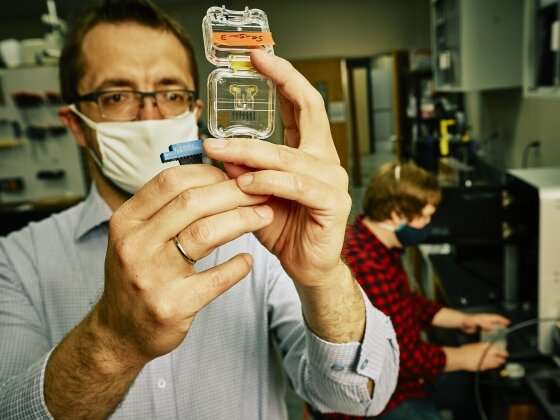Researchers harness 3-D printing to open new doors for microfluidics

Where two of the hottest fields in engineering intersect, Montana State University researchers have made a small breakthrough—literally—but one that could have a big impact across a wide range of applications.
A team led by Stephan Warnat, assistant professor in the Department of Mechanical and Industrial Engineering in MSU's Norm Asbjornson College of Engineering, has developed a new method of using 3-D printing to make devices for microfluidics, which involves manipulating very small volumes of liquid to measure water quality or study microorganisms, among other things.
"It's a big step," said Warnat, who described the advance in an article published in a scientific journal and then featured on 3dprint.com. "We're excited that our idea works the way we thought it would."
Using the new method, Warnat's team demonstrated that they could 3-D print directly onto glass to form the thin channels—less than a millimeter wide—that contain the liquid. The new process significantly reduces manufacturing time and could allow researchers to easily produce affordable, customized prototypes of the devices, called microfluidics chips, in their labs.
"The turnaround is maybe a day, from start of production to final testing," said Warnat, who estimated that materials used to make a typical chip using the new method cost about a dollar.
Typically, the channels are formed with an etching process or by masking areas of the chip and chemically depositing thin strips of material. It's important that the chip is glass because researchers usually want to view the channels with a microscope. But 3-D printing directly onto glass had proven elusive until Warnat and his collaborators figured out how to bond the printing material to the transparent substrate. Moreover, the 3-D printing material bonded well not just to the glass but to small sensors made of very thin sheets of metal. That means the sensors can be easily integrated into the microfluidics chips.
Michael Neubauer, an MSU graduate student who co-authored the article with Warnat, used the Montana Microfabrication Facility at MSU to make the metal sensors, which he described as looking like interlocking fingers that can measure changes in electrical current to detect certain minerals in water, for instance.
"These 3-D printers are pretty much available to anyone," said Neubauer, who is working toward a doctorate in engineering with a focus in mechanical engineering. "Really what we've done is bring these techniques together in way that's straightforward and that most people can accomplish in their labs. The hope is that other experts in their fields can follow these methods to come up with applications that are really cool and interesting."
Warnat himself plans to use the new technology to further his work on new, more affordable micro-sensors for measuring water quality in streams and soils. His project was one of three at MSU to win $50,000 "seed" grants that were awarded last year through the Consortium for Research on Environmental Water Systems, or CREWS, which received $20 million from the National Science Foundation earlier in 2019. The CREWS Research Seed Award Program is designed to fund innovative research related to water quality and build research capacity across Montana's higher education institutions.
Other MSU researchers, in MSU's Center for Biofilm Engineering, have expressed interest in using the new technology for a variety of research projects involving microbes. "The low cost and small size of these sensors make them very attractive for use in environmental and industrial applications where you want to take lots of measurements in multiple locations," said Christine Foreman, professor in the Department of Chemical and Biological Engineering, who has been working with Warnat's team.
"There's really a lot of opportunity for applying this technology to research across a wide range of disciplines," said Dan Miller, head of the mechanical and industrial engineering department. "The future of research is working in these interdisciplinary teams, so this puts Stephan at the cutting edge."
The collaborative nature of the Center for Biofilm Engineering, coupled with the capabilities of the Montana Microfabrication Facility, helped to inspire and support the 3-D printing advance, Warnat said. The response to the achievement has also been very encouraging, he added.
More information: M Neubauer et al. 3D printing on glass for direct sensor integration, Engineering Research Express (2019). DOI: 10.1088/2631-8695/ab5e9f



















